Classification of Plates and Trihedral Corner Reflectors Based on Linear Wavefront Phase-Modulated Beam
Abstract
:1. Introduction
2. Method
2.1. Linear Wavefront Phase-Modulated Beam
2.2. Scattering Characteristics
2.3. Feature Extraction
3. Results
3.1. Scattering Characteristics of Plates and Trihedral Corner reflectors
3.2. Classification
4. Conclusions
Author Contributions
Funding
Institutional Review Board Statement
Informed Consent Statement
Data Availability Statement
Conflicts of Interest
References
- Wang, T.; Wenjian, B.; Zhao, Y.; Xue, W. Radar Target Recognition Algorithm Based on RCS Observation Sequence-Set-Valued Identification Method. J. Syst. Sci. Complex. 2016, 29, 573–588. [Google Scholar] [CrossRef]
- Chipengo, U.; Sligar, A.P.; Canta, S.M.; Goldgruber, M.; Leibovich, H.; Carpenter, S. High Fidelity Physics Simulation-Based Convolutional Neural Network for Automotive Radar Target Classification Using Micro-Doppler. IEEE Access 2021, 9, 82597–82617. [Google Scholar] [CrossRef]
- Griffin, L.D.; Caldwell, M.; Andrews, J.T.A.; Bohler, H. “Unexpected Item in the Bagging Area”: Anomaly Detection in X-ray Security Images. IEEE Trans. Inf. Forensics Secur. 2019, 14, 1539–1553. [Google Scholar] [CrossRef]
- Marghany, M. Advanced Algorithms for Mineral and Hydrocarbon Exploration Using Synthetic Aperture Radar; Elsevier: New York, NY, USA, 2021. [Google Scholar]
- Marghany, M. Nonlinear Ocean Dynamics: Synthetic Aperture Radar; Elsevier: New York, NY, USA, 2021. [Google Scholar]
- Ai, J.; Mao, Y.; Luo, Q.; Jia, L.; Xing, M. SAR Target Classification Using the Multikernel-Size Feature Fusion-Based Convolutional Neural Network. IEEE Trans. Geosci. Remote Sens. 2022, 60, 1–13. [Google Scholar] [CrossRef]
- Sadjadi, F. Improved target classification using optimum polarimetric SAR signatures. IEEE Trans. Aerosp. Electron. Syst. 2002, 38, 38–49. [Google Scholar] [CrossRef]
- Perissin, D.; Ferretti, A. Urban-Target Recognition by Means of Repeated Spaceborne SAR Images. IEEE Trans. Geosci. Remote Sens. 2007, 45, 4043–4058. [Google Scholar] [CrossRef]
- Vassilev, V. Road surface recognition at mm-wavelengths using a polarimetric radar. IEEE Trans. Intell. Transp. Syst. 2021, 23, 6985–6990. [Google Scholar] [CrossRef]
- Xiong, G.; Xi, Y.; Chen, D. Dual-Polarization SAR Ship Target Recognition Based on Mini Hourglass Region Extraction and Dual-Channel Efficient Fusion Network. IEEE Access 2021, 99, 1. [Google Scholar] [CrossRef]
- Lee, J.S.; Pottier, E. Polarimetric Radar Imaging: From Basics to Applications; CRC Press: Boca Raton, FL, USA, 2009. [Google Scholar]
- Jafari, M.; Maghsoudi, Y.; Zoej, M. A New Component Scattering Model Using Polarimetric Signatures Based Pattern Recognition on Polarimetric SAR Data. J. Indian Soc. Remote Sens. 2016, 44, 297–306. [Google Scholar] [CrossRef]
- Dadhich, G.; Sharma, S.; Rambhia, M.; Mathur, A.K.; Patel, P.R.; Shukla, A. Image quality characterization of fine resolution RISAT-1 data using impulse response function. Int. J. Remote Sens. 2017, 38, 586–596. [Google Scholar] [CrossRef]
- Wang, S.; Chen, K.-S.; Sato, M. Performance of SAR Polarimetric Calibration Using Hybrid Corner Reflectors: Numerical Simulations and Experimental Measurements. IEEE J. Sel. Top. Appl. Earth Obs. Remote Sens. 2021, 14, 440–451. [Google Scholar] [CrossRef]
- Sergienko, A.V.; Uribe-Patarroyo, N.; Fraine, A.; Fitzpatrick, C.; Simon, D.S.; Minaeva, O. High Information Capacity Image Recognition Using Correlated Orbital Angular Momentum (OAM) States. In Frontiers in Optics 2014; Optica Publishing Group: Boston, MA, USA, 2014; p. FM4E.2. [Google Scholar]
- Tong, X. Staring high-resolution imaging algorithm based on random coded-wavefront. Signal Image Video Process. 2021, 15, 1115–1123. [Google Scholar] [CrossRef]
- Liu, K.; Cheng, Y.; Yang, Z.; Wang, H.; Qin, Y.; Li, X. Orbital-Angular-Momentum-Based Electromagnetic Vortex Imaging. IEEE Antennas Wirel. Propag. Lett. 2015, 14, 711–714. [Google Scholar] [CrossRef]
- Qiu, S.; Ren, Y.; Liu, T.; Chen, L.; Wang, C.; Li, Z.; Shao, Q. Spinning object detection based on perfect optical vortex. Opt. Lasers Eng. 2020, 124, 105842. [Google Scholar] [CrossRef]
- Bu, L.; Zhu, Y.; Chen, Y.; Yang, Y.; Zang, Y. Vortex-electromagnetic-wave-based ISAR imaging for high-speed maneuvering targets. Sci. Rep. 2022, 12, 18009. [Google Scholar] [CrossRef]
- Wu, Z.; Wu, J.; Li, H.; Qu, T.; Meng, X.; Xu, Q.; Wu, Z.; Bai, J.; Yang, L.; Gong, L.; et al. Integrated Physical Optics for Calculating Electric-Large Metallic Sphere Scattering Irradiated by Vortex Wave in Microwave Frequency Band. IEEE Antennas Wirel. Propag. Lett. 2022, 21, 1288–1292. [Google Scholar] [CrossRef]
- Zhang, X.; Su, X.; Wu, Z.; Ma, L.; Li, X.; Bai, J. Analysis of electromagnetic scattering from typical targets for orbital-angular-momentum waves: Theoretical model. IET Microw. Antennas Propag. 2022, 16, 699–708. [Google Scholar] [CrossRef]
- Liu, K.; Liu, H.; Sha, W.E.I.; Cheng, Y.; Wang, H. Backward Scattering of Electrically Large Standard Objects Illuminated by OAM Beams. IEEE Antennas Wirel. Propag. Lett. 2020, 19, 1167–1171. [Google Scholar] [CrossRef]
- Liu, K.; Gao, Y.; Li, X.; Cheng, Y. Target scattering characteristics for OAM-based radar. AIP Adv. 2018, 8, 025002. [Google Scholar] [CrossRef]
- Tang, B.; Bai, J.; Sheng, X. Orbital-angular-momentum-carrying wave scattering by the chaff clouds. IET Radar Sonar Navig. 2018, 12, 649–653. [Google Scholar]
- Liao, Y.; Yang, S.; Li, K.; Ji, J.; Lin, X.; Hao, Y.; Li, Z.; Wang, X.; Zhang, J. Reduction of Scattering Clutters in an Underwater Lidar System by Using an Optical Vortex. IEEE Photonics Technol. Lett. 2022, 34, 927–930. [Google Scholar] [CrossRef]
- Zhang, C.; Chen, D.; Jiang, X. RCS Diversity of Electromagnetic Wave Carrying Orbital Angular Momentum. Sci. Rep. 2018, 7, 15412. [Google Scholar] [CrossRef] [PubMed] [Green Version]
- Zhang, C.; Jiang, X.; Chen, D. Signal-to-Noise Ratio Improvement by Vortex Wave Detection With a Rotational Antenna. IEEE Trans. Antennas Propag. 2018, 99, 1. [Google Scholar] [CrossRef]
- Feng, P.-Y.; Qu, S.-W.; Yang, S. OAM-Generating Transmitarray Antenna With Circular Phased Array Antenna Feed. IEEE Trans. Antennas Propag. 2020, 68, 4540–4548. [Google Scholar] [CrossRef]
- Zhong, Y.; Zhang, Y.; Zhang, X.; Sun, H.; Zhao, G. Velocity measurement of an arbitrary three-dimensional moving object by using a novel modulated field. Opt. Express 2021, 29, 26210–26219. [Google Scholar] [CrossRef]
- Knott, E. Radar Cross Section; Artech House, Inc.: Norwood, MA, USA, 1985. [Google Scholar]
- Mathur, A.; Foody, G.M. Multiclass and Binary SVM Classification: Implications for Training and Classification Users. IEEE Geosci. Remote Sens. Lett. 2008, 5, 241–245. [Google Scholar] [CrossRef]
- Yu, H.; Sun, W.; Zhou, X.; Zhu, G.; Hu, W. Heuristic sample reduction based support vector regression method. In Proceedings of the IEEE International Conference on Mechatronics and Automation, Harbin, China, 7–10 August 2016; pp. 2065–2069. [Google Scholar]
- Zhang, G.; Cao, Y.; Chen, J.; Huang, P.; Ge, W.; Hou, D. Classification and identification of human colon cancer cell line in terahertz domain using t-SNE. In Clinical and Preclinical Optical Diagnostics II; Optica Publishing Group: Hangzhou, China, 2019; p. 11073_45. [Google Scholar]
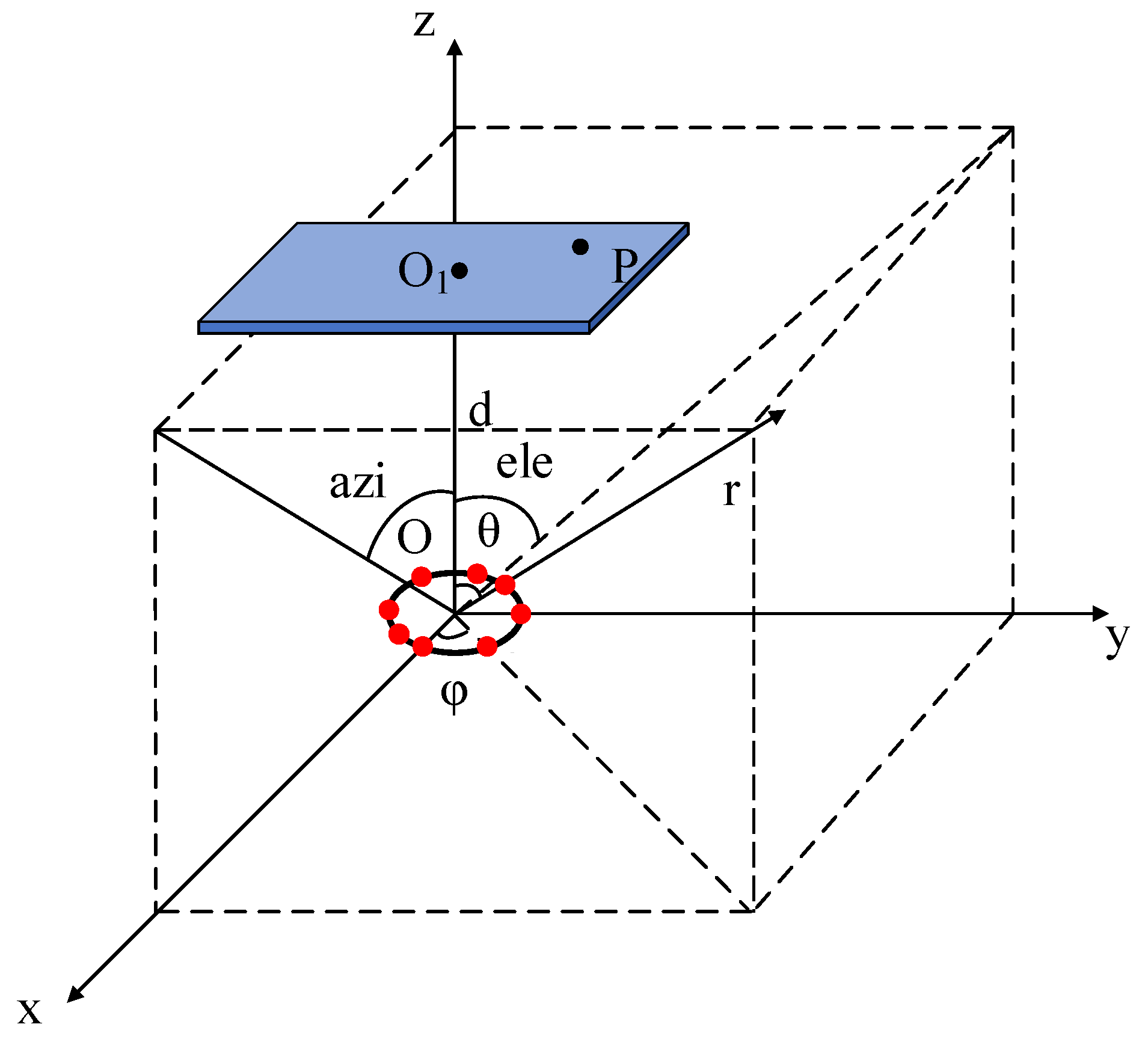

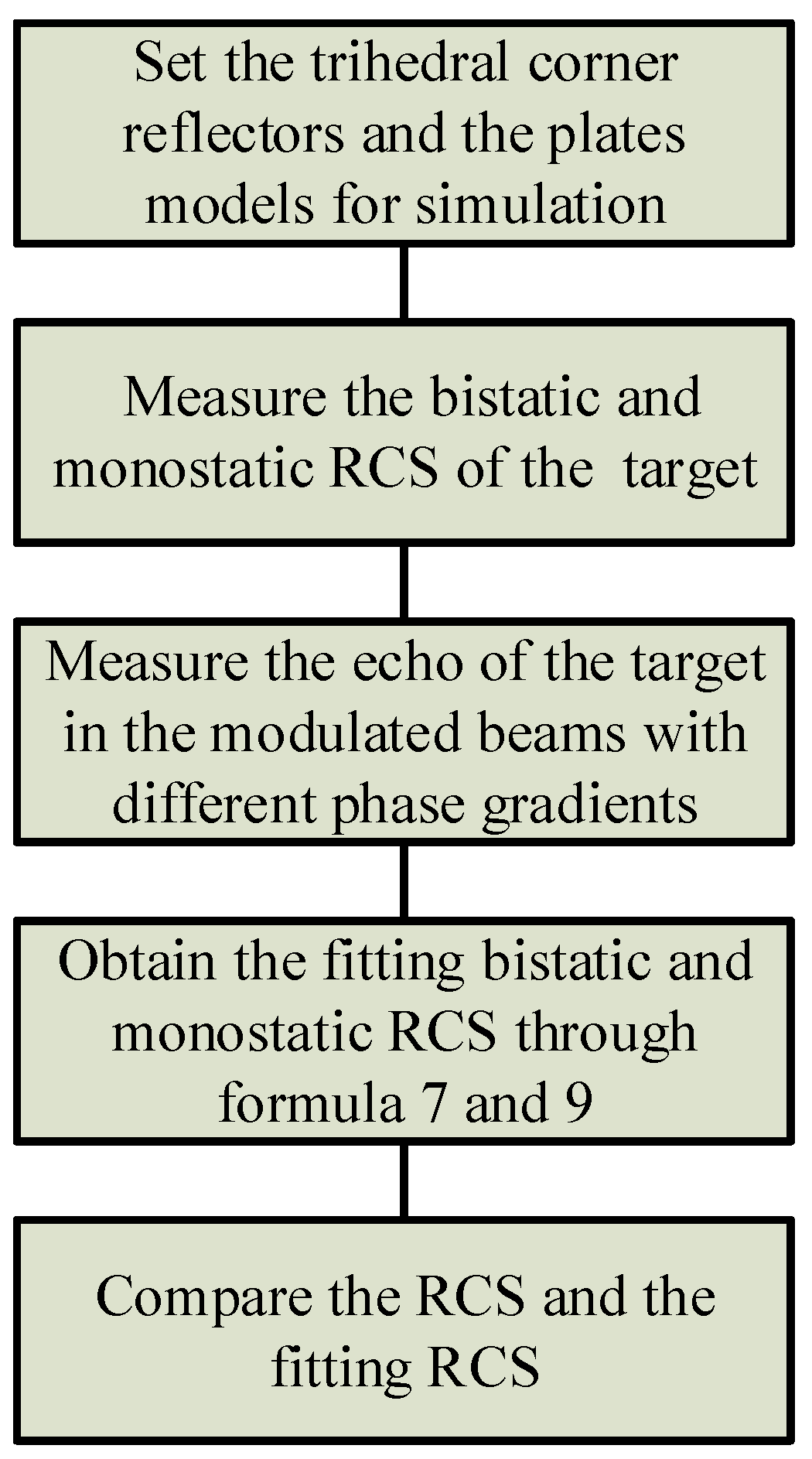
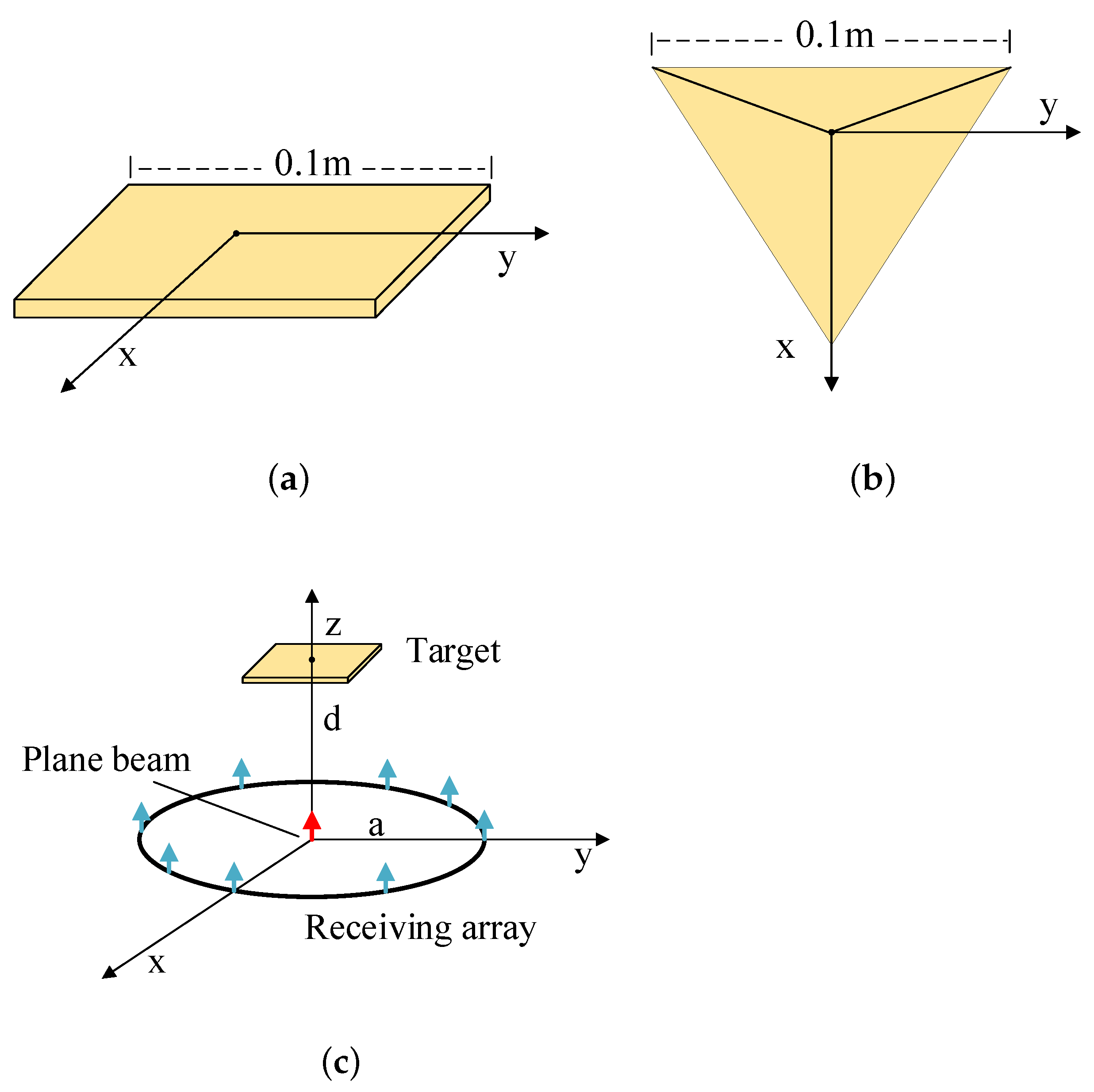

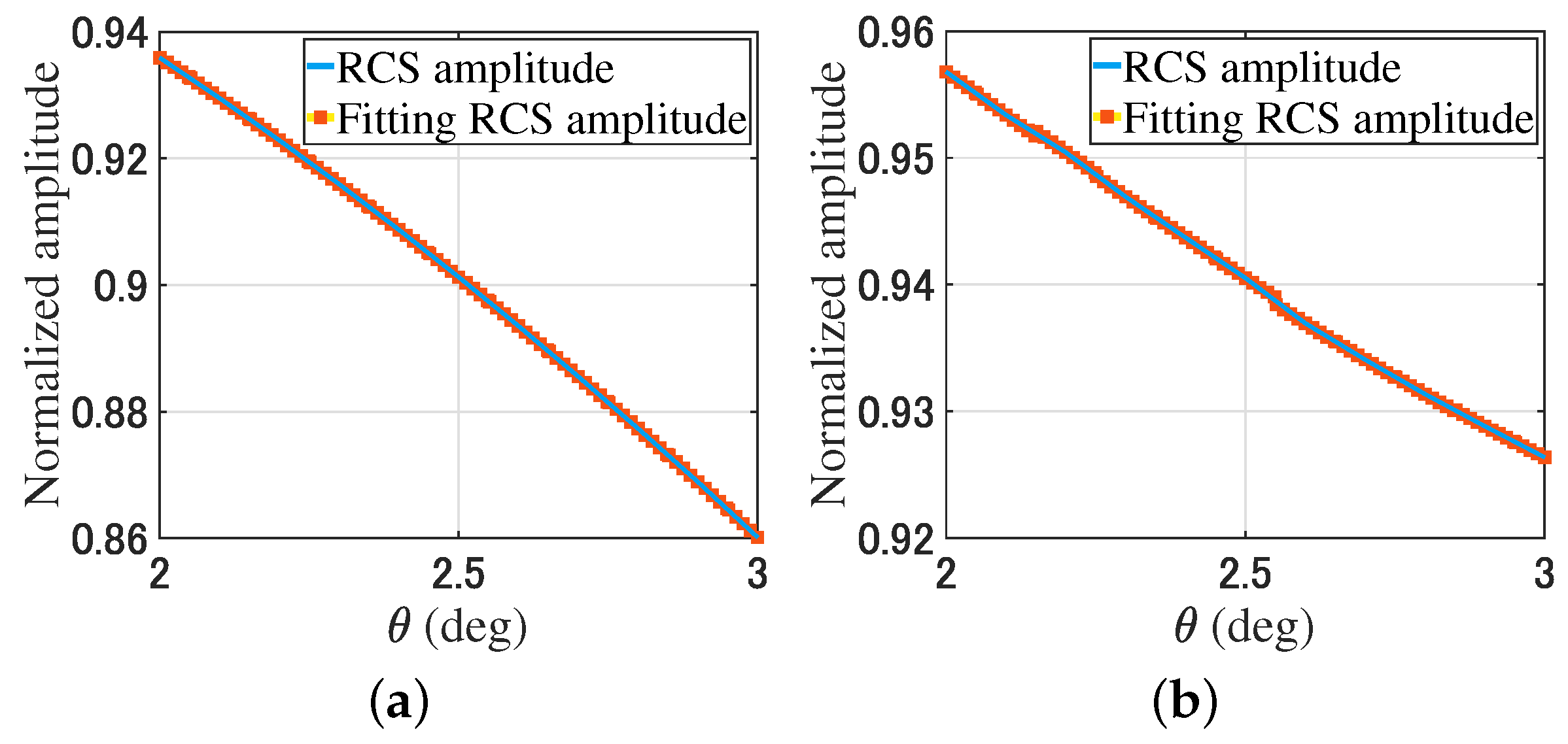

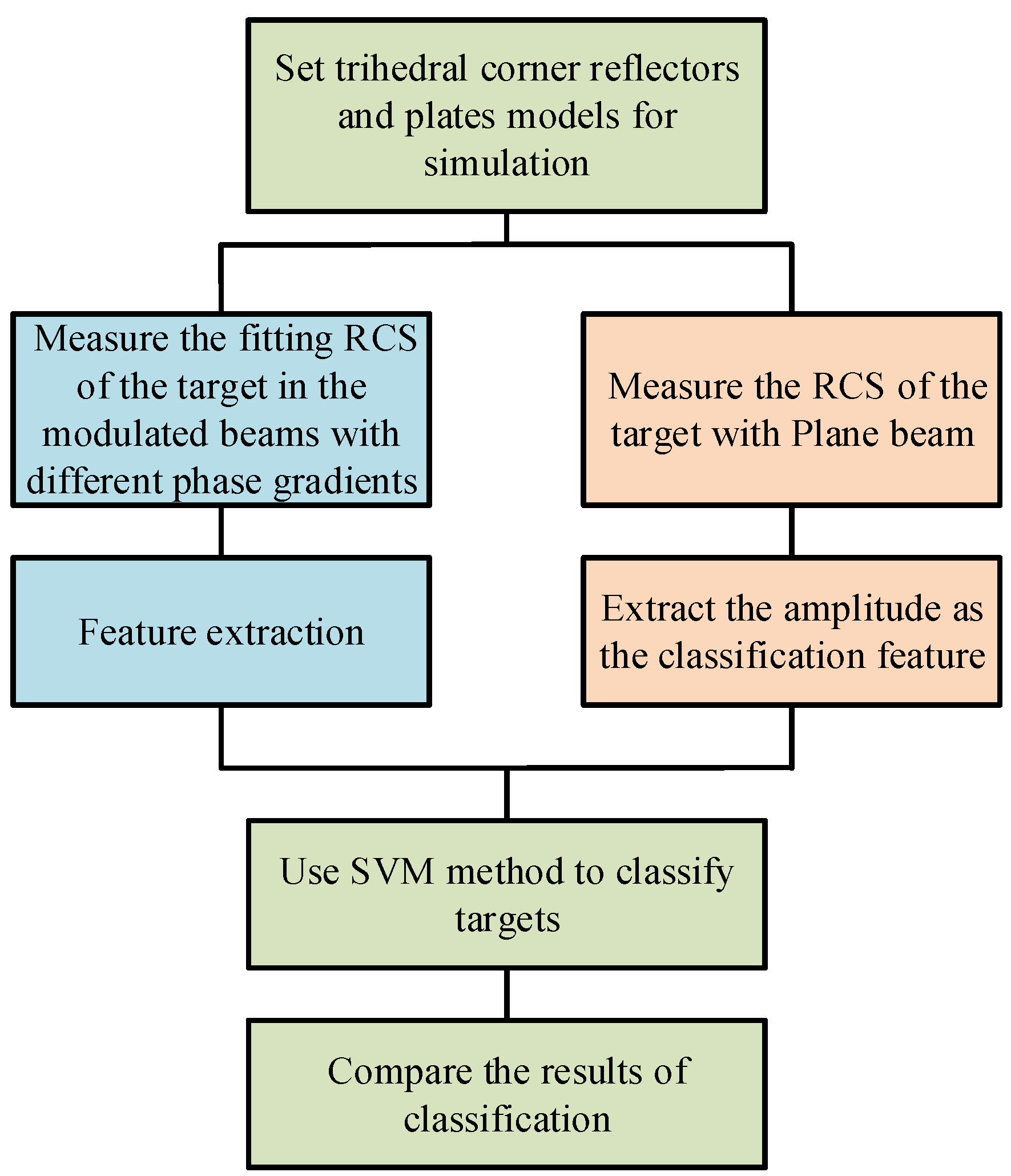
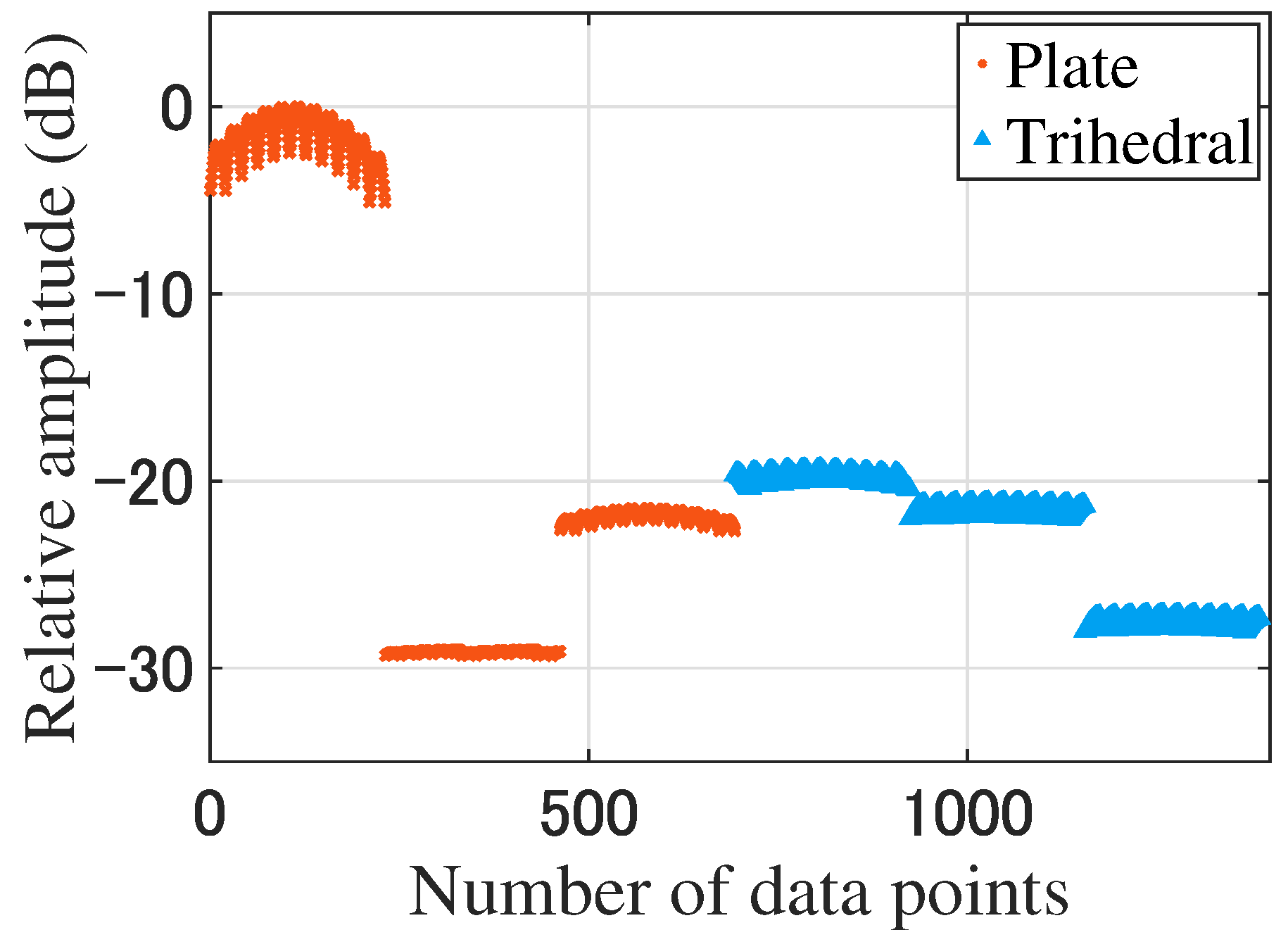


| N-th unit | 1 | 2 | 3 | 4 | 5 | 6 | 7 | 8 |
| Plane | 1 | 1 | 1 | 1 | 1 | 1 | 1 | 1 |
| Modulated I | 0.1 | 0.55 | 1 | 1.45 | 1.9 | 1.45 | 1 | 0.55 |
| Modulated II | 1 | 0.55 | 0.1 | 0.55 | 1 | 1.45 | 1.9 | 1.45 |
| N-th unit | 1 | 2 | 3 | 4 | 5 | 6 | 7 | 8 |
| receiving | 1 | 1 | 1 | 1 + t | 1 + 2t | 1 + t | 1 | 1 |
| Type | Distance (m) | Length of Side (m) |
|---|---|---|
| Trihedral | 2 | 0.125 |
| Trihedral | 2 | 0.1 |
| Trihedral | 4 | 0.05 |
| Plate | 2 | 0.1 |
| Plate | 4 | 0.025 |
| Plate | 6 | 0.05 |
| N-th unit | 1 | 2 | 3 | 4 | 5 | 6 | 7 | 8 |
| receiving | 1 | 1 | 1 | 1 | 1 | 1 + t | 1 + 2t | 1 + t |
| Average of Multiple Experiments | Predicted Class | ||
|---|---|---|---|
| Plate | Trihedral | ||
| Actual class (Modulated beam) | Plate | 100% | 0% |
| Trihedral | 1.45% | 98.55% | |
| Actual class (Plane beam) | Plate | 67.39% | 32.61% |
| Trihedral | 33.09% | 66.91% | |
Publisher’s Note: MDPI stays neutral with regard to jurisdictional claims in published maps and institutional affiliations. |
© 2022 by the authors. Licensee MDPI, Basel, Switzerland. This article is an open access article distributed under the terms and conditions of the Creative Commons Attribution (CC BY) license (https://creativecommons.org/licenses/by/4.0/).
Share and Cite
Wang, X.; Zhang, Y.; Zhu, K.; Zhang, X.; Sun, H. Classification of Plates and Trihedral Corner Reflectors Based on Linear Wavefront Phase-Modulated Beam. Electronics 2022, 11, 4044. https://doi.org/10.3390/electronics11234044
Wang X, Zhang Y, Zhu K, Zhang X, Sun H. Classification of Plates and Trihedral Corner Reflectors Based on Linear Wavefront Phase-Modulated Beam. Electronics. 2022; 11(23):4044. https://doi.org/10.3390/electronics11234044
Chicago/Turabian StyleWang, Xiaodong, Yi Zhang, Kaiqiang Zhu, Xiangdong Zhang, and Houjun Sun. 2022. "Classification of Plates and Trihedral Corner Reflectors Based on Linear Wavefront Phase-Modulated Beam" Electronics 11, no. 23: 4044. https://doi.org/10.3390/electronics11234044





